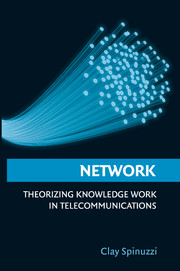Book contents
- Frontmatter
- Contents
- Acknowledgments
- 1 Networks, Genres, and Four Little Disruptions
- 2 What Is a Network?
- 3 How Are Networks Theorized?
- 4 How Are Networks Historicized?
- 5 How Are Networks Enacted?
- 6 Is Our Network Learning?
- 7 Conclusion: How Does Net Work Work?
- Appendix Notes on Methodology
- Works Cited
- Index
5 - How Are Networks Enacted?
Published online by Cambridge University Press: 08 August 2009
- Frontmatter
- Contents
- Acknowledgments
- 1 Networks, Genres, and Four Little Disruptions
- 2 What Is a Network?
- 3 How Are Networks Theorized?
- 4 How Are Networks Historicized?
- 5 How Are Networks Enacted?
- 6 Is Our Network Learning?
- 7 Conclusion: How Does Net Work Work?
- Appendix Notes on Methodology
- Works Cited
- Index
Summary
We've seen how work at Telecorp is deeply interpenetrated and how this has historically occurred. Telecorp has taken a strategic stance, as I argued in Chapter 4, but it's a stance into which many other companies and organizations have also shifted. In such organizations, everyone is at the border; everyone can link up with anyone else inside or outside the organization. This is what I've been calling the net work, the coordinative work that weaves and splices divergent work activities and that enables the standing sets of transformations that characterize such work. This coordinative, polycontextual, cross-disciplinary work, which makes this interpenetration hold together, has been noted in scholarship focusing on what is variably called the “new economy,” the “knowledge economy,” the “control society,” the “politics of informatics,” the “support economy,” and the “hyperlinked organization.”
But if everyone is massed at the border – if the organization is not arborescent but rhizomatic – how does the company work? Isn't that different from traditional work?
Sure it is. The modular understanding of work that we get from chained activity networks and from similar understandings of work – both Marxist and Taylorist (Braverman, 1974; Ehn, 1989; Marx, 1990) – isn't adequate for explaining what is going on at Telecorp or any other deeply interpenetrated organization, particularly those performing knowledge work. Given that, how is this net work done? That is, how are networks constructed and repaired, how are new nodes added, and how do workers collaborate?
Information
- Type
- Chapter
- Information
- NetworkTheorizing Knowledge Work in Telecommunications, pp. 135 - 172Publisher: Cambridge University PressPrint publication year: 2008
